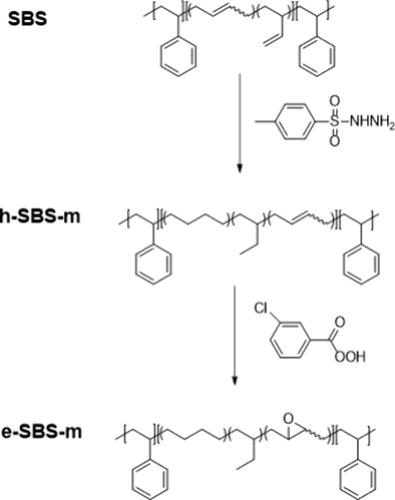用于阴离子交换膜的环氧化聚苯乙烯-b-聚丁二烯-b-聚苯乙烯的同时后官能化和交联技术
IF 5.4
3区 材料科学
Q2 CHEMISTRY, PHYSICAL
引用次数: 0
摘要
阴离子交换膜(AEM)是许多电化学设备(如燃料电池和电解槽)的关键材料组成部分。然而,其相对较低的氢氧化物传导性以及不足的长期化学和机械稳定性一直是广泛采用基于 AEM 技术的主要障碍。为了解决这些问题,人们探索了各种合成方法,以提高离子交换能力并在膜中引入交联剂。然而,这些方法通常需要多个合成步骤才能实现具有可定制功能的整体材料特性。本文报告了一种同时加入溴烷基侧链和化学交联剂的简便合成方法,用于制备 AEM。以部分环氧化的聚苯乙烯-聚丁二烯-聚苯乙烯(SBS)为前体材料,通过紫外线引发的阳离子环氧开环聚合同时进行了聚合物官能化和交联反应。通过调整环氧化 SBS 和 2-(6-溴己基)环氧乙烷添加剂之间环氧基团的摩尔比来控制官能化/交联程度。与交联 AEM 的典型方法不同,我们的原位交联 AEM 具有分子设计优势,可将季铵阳离子基团置于柔性烷基间隔物的末端。这种 AEM 材料设计可能会产生有利的链构型,通过良好连接的离子传导通道促进更好的离子聚集和离子传输。由此产生的交联 SBS AEM 具有较高的氢氧化物传导性(80 °C 时为 0.1 S/cm)、良好的机械强度和韧性,并保持了良好的碱性稳定性(在 80 °C 的 1 M NaOH 溶液中浸泡 500 小时后无降解)。本文章由计算机程序翻译,如有差异,请以英文原文为准。

Simultaneous Postfunctionalization and Cross-Linking of Epoxidized Polystyrene-b-polybutadiene-b-polystyrene for Anion Exchange Membrane
Anion exchange membrane (AEM) is a key material component of many electrochemical devices, such as fuel cells and electrolyzers. However, its relatively low hydroxide conductivity and insufficient long-term chemical and mechanical stabilities have been major barriers to the wider adoption of AEM-based technologies. To address those issues, various synthetic approaches have been explored with the aim of increasing ion exchange capacity and introducing cross-linkers within the membrane. These approaches, however, typically require multiple synthetic steps to achieve the overall material properties with tailorable functionality. Herein, a facile synthetic method to simultaneously incorporate bromoalkyl side chains and chemical cross-linkers is reported for the preparation of AEMs. Using partially epoxidized polystyrene-b-polybutadiene-b-polystyrene (SBS) as a precursor material, simultaneous polymer functionalization and cross-linking reactions were carried out via UV-initiated cationic epoxy ring-opening polymerization. The extent of functionalization/cross-linking was controlled by tailoring the molar ratio of the epoxy group between epoxidized SBS and 2-(6-bromohexyl)oxirane additive. In contrast to the typical approach to cross-linked AEM, our in situ cross-linked AEMs offer the advantage of molecular design to locate quaternary ammonium cationic groups at the end of flexible alkyl spacers. This AEM material design is likely to result in favorable chain configurations for better ionic aggregation and ion transport facilitated by well-connected ionic conducting channels. The resulting cross-linked SBS AEM exhibits high hydroxide conductivity (>0.1 S/cm at 80 °C) and good mechanical strength and toughness, retaining good alkaline stability (no degradation after immersing in 1 M NaOH solution at 80 °C for 500 h).
求助全文
通过发布文献求助,成功后即可免费获取论文全文。
去求助
来源期刊

ACS Applied Energy Materials
Materials Science-Materials Chemistry
CiteScore
10.30
自引率
6.20%
发文量
1368
期刊介绍:
ACS Applied Energy Materials is an interdisciplinary journal publishing original research covering all aspects of materials, engineering, chemistry, physics and biology relevant to energy conversion and storage. The journal is devoted to reports of new and original experimental and theoretical research of an applied nature that integrate knowledge in the areas of materials, engineering, physics, bioscience, and chemistry into important energy applications.
 求助内容:
求助内容: 应助结果提醒方式:
应助结果提醒方式:


